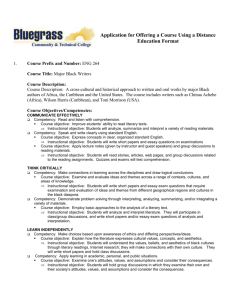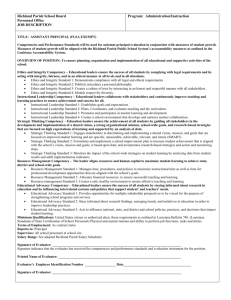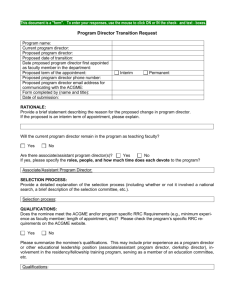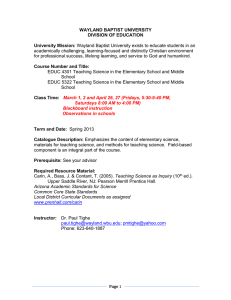Guidelines For Writing Goals And Objectives
advertisement
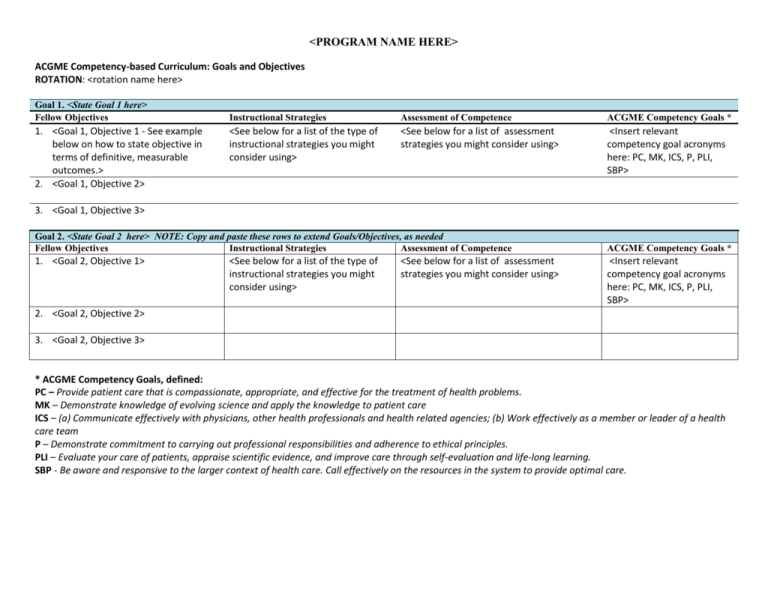
<PROGRAM NAME HERE> ACGME Competency-based Curriculum: Goals and Objectives ROTATION: <rotation name here> Goal 1. <State Goal 1 here> Fellow Objectives 1. <Goal 1, Objective 1 - See example below on how to state objective in terms of definitive, measurable outcomes.> 2. <Goal 1, Objective 2> Instructional Strategies Assessment of Competence ACGME Competency Goals * <See below for a list of the type of instructional strategies you might consider using> <See below for a list of assessment strategies you might consider using> <Insert relevant competency goal acronyms here: PC, MK, ICS, P, PLI, SBP> 3. <Goal 1, Objective 3> Goal 2. <State Goal 2 here> NOTE: Copy and paste these rows to extend Goals/Objectives, as needed Fellow Objectives Instructional Strategies Assessment of Competence 1. <Goal 2, Objective 1> <See below for a list of the type of instructional strategies you might consider using> <See below for a list of assessment strategies you might consider using> ACGME Competency Goals * <Insert relevant competency goal acronyms here: PC, MK, ICS, P, PLI, SBP> 2. <Goal 2, Objective 2> 3. <Goal 2, Objective 3> * ACGME Competency Goals, defined: PC – Provide patient care that is compassionate, appropriate, and effective for the treatment of health problems. MK – Demonstrate knowledge of evolving science and apply the knowledge to patient care ICS – (a) Communicate effectively with physicians, other health professionals and health related agencies; (b) Work effectively as a member or leader of a health care team P – Demonstrate commitment to carrying out professional responsibilities and adherence to ethical principles. PLI – Evaluate your care of patients, appraise scientific evidence, and improve care through self-evaluation and life-long learning. SBP - Be aware and responsive to the larger context of health care. Call effectively on the resources in the system to provide optimal care. GUIDELINES FOR WRITING GOALS AND OBJECTIVES 1. State objectives in terms of specific measureable outcomes. Instead of using broad terms like “Learn” “Know” or “Understand” try using more definitive and measurable outcomes. Following Bloom’s Taxonomy of Learning Domains (1956), the categories and lists below start with the simplest behaviors to more complex. This is not an exhaustive list, rather a starting point on how to define the objectives with measurable outcomes. KNOWLEDGE Define Describe Identify Label List Match Name Outline Recall Recognize Reproduce Select State COMPREHENSION Comprehend Convert Defend Distinguish Estimate Explain Extend Generalize Gives an example Infer Interpret Paraphrase Predict Summarize Translate APPLICATION Apply Change Construct Demonstrate Discover Manipulate Modify Monitor Operate Predict Prepare Present Produce Relate Solve Use ANALYSIS Analyze Compare Contrast Diagram Deconstruct Differentiate Discriminate Distinguish Identify Illustrate Infer Outline Relate Select Separate 2. Instructional strategies you might consider using are listed below. Again this is not an exhaustive list. Participation in Rounds Direct Patient care experience Audio or video reviews Textbook and journal readings (Identify readings if possible) Didactic conference Simulation training Role Playing Workshops Role modeling by Attending Problem-based activity QI Project Patient/Family conferences SYNTHESIS Categorize Compile Create Devise Design Explain Generate Modify Organize Plan Rearrange Relate Reorganize Revise Summarize Write EVALUATION Appraise Compare Conclude Contrast Criticize Critique Defend Describe Discriminate Evaluate Explain Interpret Justify Relate Summarize Support 3. Assessment of Competencies. Following are some commonly used evaluation methods. Rating /Evaluation Forms by Attending Rating /Evaluation Forms by Patients and Families Self-assessment and reflection forms Essays on experience (self reflection) Written or computer-interactive tests Oral examinations and questions Individual interviews Group interviews and discussions Performance audits Direction Observation These forms of evaluation can come in the context of: Attending verbal or written, timely feedback on patient interaction/communication Direct observation and feedback on patient care clinical decisions Faculty evaluations (yearly, or at end of rotations) Observation and feedback on rounds Documentation of procedures Assessment of presentations at journal clubs and conferences Simulation training feedback Review of resident orders Review and feedback on QI Projects Written patient and family evaluations 360 evaluations Portfolio work Course completion and tests Feedback on presentations on research interest or selected readings References: Bloom B. S. (1956). Taxonomy of Educational Objectives, Handbook I: The Cognitive Domain. New York: David McKay Co Inc. Kern, D., Thomas, P.A., Howard, D.M. and Bass, E.B. (1998). Curriculum Development for Medical Education: A six-step approach. Baltimore, Maryland: The John Hopkins University Press.
